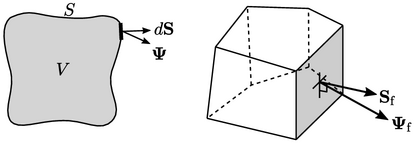3.19 Calculated derivatives
The introduction to matrix construction,
Sec. 3.5
, described implicit
and explicit discretisation of terms in an equation. It concluded
that the principal derivatives of  that can be treated
implicitly — forming matrix coefficients in
that can be treated
implicitly — forming matrix coefficients in  — are a time
derivative, advection and Laplacian.
— are a time
derivative, advection and Laplacian.
Terms with other derivatives must be calculated
from respective fields, e.g.
 from current values of
from current values of  . In Sec. 3.15
, we have described
discretisation of a gradient, which is always explicit. This
section gathers together the other derivatives found in equations
for fluid dynamics and associated models.
. In Sec. 3.15
, we have described
discretisation of a gradient, which is always explicit. This
section gathers together the other derivatives found in equations
for fluid dynamics and associated models.
General divergence term
A general divergence term is any term that can
be represented by  . It excludes the Laplacian term which includes
a gradient
. It excludes the Laplacian term which includes
a gradient  , and advection which includes
, and advection which includes  .
.

The discretisation of a general divergence term
is an explicit calculation using current values of  . It is based on a
surface integral using the divergence definition in
Sec. 2.23
as shown below:
. It is based on a
surface integral using the divergence definition in
Sec. 2.23
as shown below:
 |
(3.30) |
 is generally interpolated from cell values using the
linear scheme. Terms discretised using this scheme include
is generally interpolated from cell values using the
linear scheme. Terms discretised using this scheme include
 in
Eq. (2.45
), a divergence of
stress
in
Eq. (2.45
), a divergence of
stress  , etc.
, etc.
Curl of a vector
The curl derivative  is calculated from the
gradient
is calculated from the
gradient  and applying the Hodge dual operator given by
Eq. (2.40
) using the following
relation:
and applying the Hodge dual operator given by
Eq. (2.40
) using the following
relation:
 |
(3.31) |
 is discretised according to a scheme from
Sec. 3.15
, from which
is discretised according to a scheme from
Sec. 3.15
, from which  is calculated by
Eq. (3.31
).
is calculated by
Eq. (3.31
).
Mag-square grad-grad
A derivative which appears in some model
equations is  , described as “mag-square grad-grad”. This derivative
returns a scalar since the mag-square, e.g.
, described as “mag-square grad-grad”. This derivative
returns a scalar since the mag-square, e.g.  , represents the inner
product of
, represents the inner
product of  with itself, as shown in Eq. (2.7
).
with itself, as shown in Eq. (2.7
).
The mag-square calculation always uses the
appropriate inner product to reduce the result to a scalar. For a
tensor  , it is the double inner product, i.e.
, it is the double inner product, i.e.  .
.
The grad-grad operator  yields a third-rank
tensor in the case that
yields a third-rank
tensor in the case that  is a vector field. To avoid storing
third-rank tensors, the mag-square grad-grad operator is evaluated
by summing the result from the operator on each component
is a vector field. To avoid storing
third-rank tensors, the mag-square grad-grad operator is evaluated
by summing the result from the operator on each component  of
of  by
by
 |
(3.32) |
 is the number of components in
is the number of components in  .
.

